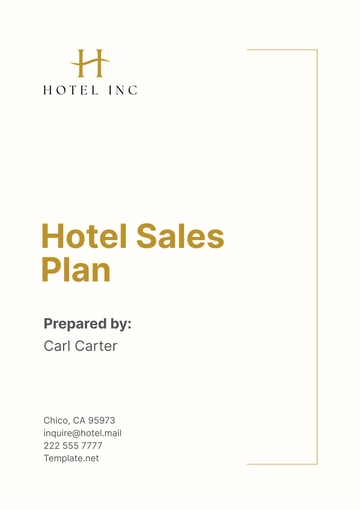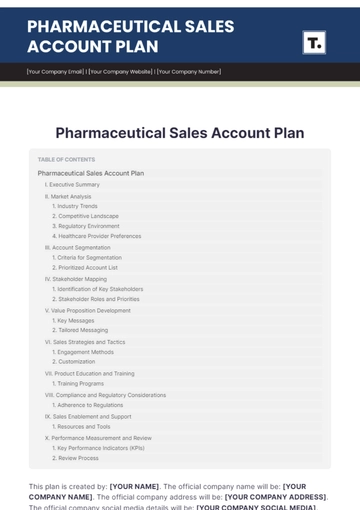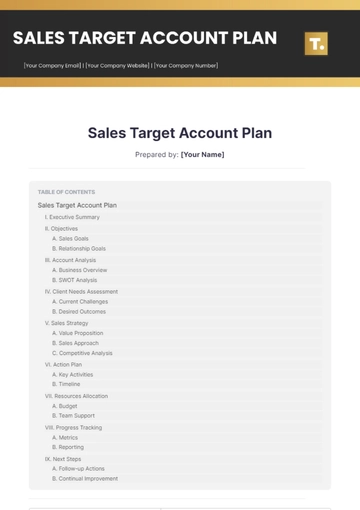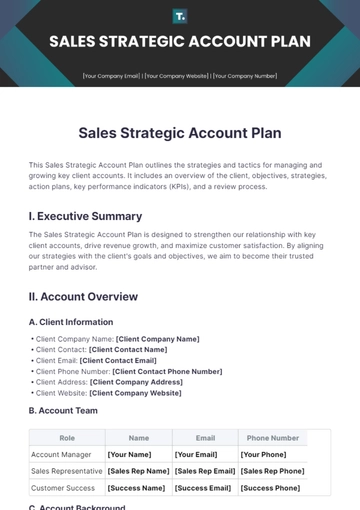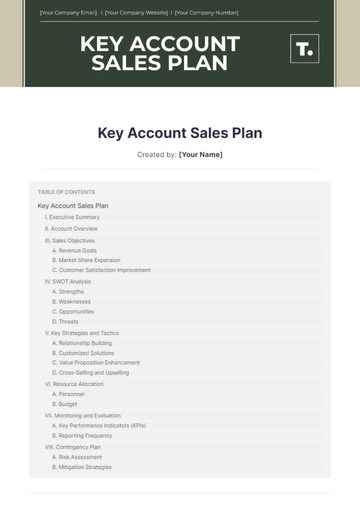Free Sales Account Plan

Created by: [YOUR NAME]
I. Executive Summary
[YOUR COMPANY NAME] has created this Sales Account Plan to outline the strategy, objectives, and actions necessary to achieve and maintain high sales performance for [Client Company Name]. This plan includes a comprehensive review of the current business situation, market conditions, and sales objectives, coupled with detailed action plans and responsible parties.
II. Client Information
1. Client Overview
Client Name: [Client Company Name]
Client Address: [Client Company Address]
Client Contact Person: [Client Contact Person]
Client Contact Email: [Client Contact Email]
Client Contact Phone: [Client Contact Phone]
2. Key Stakeholders
List of individuals from both [YOUR COMPANY NAME] and [Client Company Name] involved in the decision-making and execution of this account plan:
Bringing expertise in [relevant field] to drive strategic initiatives and foster mutual success.
Spearheading [specific aspect] to ensure seamless integration and alignment with overarching objectives.
Orchestrating [key responsibility] to optimize workflows and deliver value at every stage of the partnership.
III. Sales Objectives
1. Revenue Targets
Define the specific revenue targets for the client account over designated periods:
Time Period | Target Revenue |
|---|---|
Quarter 1, 2050 | [Target] |
Quarter 2, 2050 | [Target] |
Quarter 3, 2050 | [Target] |
Quarter 4, 2050 | [Target] |
2. Sales Goals
Additional sales goals to support revenue targets:
Elevate product penetration within [Specific Market/Category] through targeted strategies aimed at capturing a larger share of the market.
Expand our client base by [Percentage] by identifying and engaging with new prospects, leveraging our strengths and unique value propositions.
Enhance customer retention by [Percentage] through personalized outreach initiatives, proactive support, and the delivery of exceptional customer experiences."
IV. Key Strategies
1. Market Analysis
A brief analysis of the current market environment, including opportunities and risks:
Opportunities: Diverse growth prospects, including emerging markets and technological advancements, await exploration. Strategic partnerships offer avenues for expansion and innovation, fostering competitiveness.
Risks: Market volatility, regulatory changes, and technological disruptions pose threats. Dependencies on single suppliers or key personnel require mitigation to safeguard operations.
2. Sales Tactics
Outline specific sales tactics to be employed, such as:
Enhance digital marketing initiatives
Implement targeted email campaigns
Conduct regular client check-ins and relationship-building activities
3. Product Positioning
Detail how [YOUR COMPANY NAME]'s products and services will be positioned to meet the client’s needs:
Market Analysis: Identify competitors, consumer preferences, and trends.
Unique Value Proposition: Highlight what sets us apart.
Target Audience Segmentation: Personalize messaging for different segments.
Brand Personality: Define our identity and values.
Emphasize Quality and Innovation: Showcase our excellence.
Solve Pain Points: Position as a solution provider.
Clear Messaging: Communicate benefits effectively.
Consistent Positioning: Ensure coherence across channels.
Monitor and Adapt: Stay responsive to market changes.
V. Action Plan
1. Action Items
List of specific actions needed to achieve the sales objectives:
Identify and prioritize top accounts in [Market/Category]
Develop personalized sales proposals for each target account
Schedule and conduct initial client meetings
2. Timeline
Set a clear timeline with milestones:
Milestone | Deadline |
|---|---|
Initial Research and Contact | [Deadline 1] |
Proposal Submission | [Deadline 2] |
Client Meetings | [Deadline 3] |
VI. Performance Metrics
1. Key Performance Indicators (KPIs)
Define KPIs to monitor the success of the sales plan:
Revenue Growth: Track the percentage increase in revenue to gauge sales plan effectiveness.
Customer Acquisition Cost: Monitor expenses per new customer to optimize resource allocation.
Client Retention Rate: Evaluate the percentage of retained customers to measure long-term relationship success.
2. Reporting and Review
Establish a reporting and review process:
Monthly performance reviews
Quarterly strategy assessments
Year-end comprehensive review
Contact Details
Company: [YOUR COMPANY NAME]
Address: [YOUR COMPANY ADDRESS]
Social Media: [YOUR COMPANY SOCIAL MEDIA]
- 100% Customizable, free editor
- Access 1 Million+ Templates, photo’s & graphics
- Download or share as a template
- Click and replace photos, graphics, text, backgrounds
- Resize, crop, AI write & more
- Access advanced editor
Elevate your sales strategy with Template.net's Sales Account Plan Template. Crafted for versatility, it's both editable and customizable, ensuring tailored precision to your business needs. Seamlessly adjust objectives, forecasts, and strategies with ease using our AI Editor Tool. Streamline your sales journey and maximize productivity with this indispensable resource. Unlock your potential for success today.
You may also like
- Finance Plan
- Construction Plan
- Sales Plan
- Development Plan
- Career Plan
- Budget Plan
- HR Plan
- Education Plan
- Transition Plan
- Work Plan
- Training Plan
- Communication Plan
- Operation Plan
- Health And Safety Plan
- Strategy Plan
- Professional Development Plan
- Advertising Plan
- Risk Management Plan
- Restaurant Plan
- School Plan
- Nursing Home Patient Care Plan
- Nursing Care Plan
- Plan Event
- Startup Plan
- Social Media Plan
- Staffing Plan
- Annual Plan
- Content Plan
- Payment Plan
- Implementation Plan
- Hotel Plan
- Workout Plan
- Accounting Plan
- Campaign Plan
- Essay Plan
- 30 60 90 Day Plan
- Research Plan
- Recruitment Plan
- 90 Day Plan
- Quarterly Plan
- Emergency Plan
- 5 Year Plan
- Gym Plan
- Personal Plan
- IT and Software Plan
- Treatment Plan
- Real Estate Plan
- Law Firm Plan
- Healthcare Plan
- Improvement Plan
- Media Plan
- 5 Year Business Plan
- Learning Plan
- Marketing Campaign Plan
- Travel Agency Plan
- Cleaning Services Plan
- Interior Design Plan
- Performance Plan
- PR Plan
- Birth Plan
- Life Plan
- SEO Plan
- Disaster Recovery Plan
- Continuity Plan
- Launch Plan
- Legal Plan
- Behavior Plan
- Performance Improvement Plan
- Salon Plan
- Security Plan
- Security Management Plan
- Employee Development Plan
- Quality Plan
- Service Improvement Plan
- Growth Plan
- Incident Response Plan
- Basketball Plan
- Emergency Action Plan
- Product Launch Plan
- Spa Plan
- Employee Training Plan
- Data Analysis Plan
- Employee Action Plan
- Territory Plan
- Audit Plan
- Classroom Plan
- Activity Plan
- Parenting Plan
- Care Plan
- Project Execution Plan
- Exercise Plan
- Internship Plan
- Software Development Plan
- Continuous Improvement Plan
- Leave Plan
- 90 Day Sales Plan
- Advertising Agency Plan
- Employee Transition Plan
- Smart Action Plan
- Workplace Safety Plan
- Behavior Change Plan
- Contingency Plan
- Continuity of Operations Plan
- Health Plan
- Quality Control Plan
- Self Plan
- Sports Development Plan
- Change Management Plan
- Ecommerce Plan
- Personal Financial Plan
- Process Improvement Plan
- 30-60-90 Day Sales Plan
- Crisis Management Plan
- Engagement Plan
- Execution Plan
- Pandemic Plan
- Quality Assurance Plan
- Service Continuity Plan
- Agile Project Plan
- Fundraising Plan
- Job Transition Plan
- Asset Maintenance Plan
- Maintenance Plan
- Software Test Plan
- Staff Training and Development Plan
- 3 Year Plan
- Brand Activation Plan
- Release Plan
- Resource Plan
- Risk Mitigation Plan
- Teacher Plan
- 30 60 90 Day Plan for New Manager
- Food Safety Plan
- Food Truck Plan
- Hiring Plan
- Quality Management Plan
- Wellness Plan
- Behavior Intervention Plan
- Bonus Plan
- Investment Plan
- Maternity Leave Plan
- Pandemic Response Plan
- Succession Planning
- Coaching Plan
- Configuration Management Plan
- Remote Work Plan
- Self Care Plan
- Teaching Plan
- 100-Day Plan
- HACCP Plan
- Student Plan
- Sustainability Plan
- 30 60 90 Day Plan for Interview
- Access Plan
- Site Specific Safety Plan













